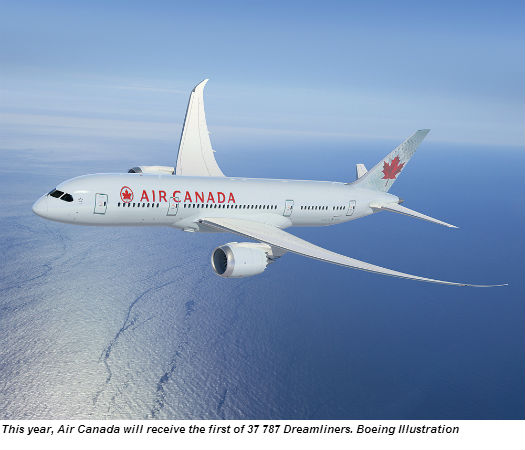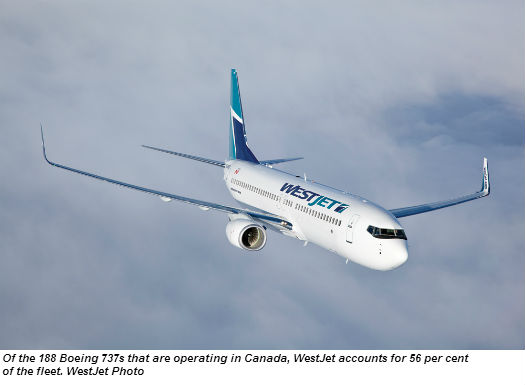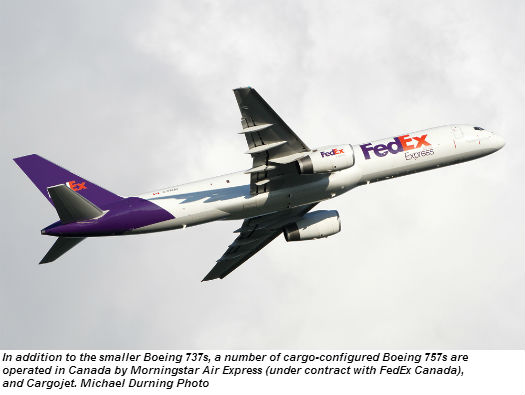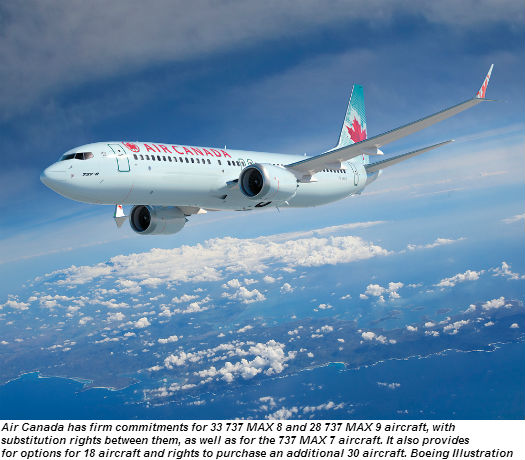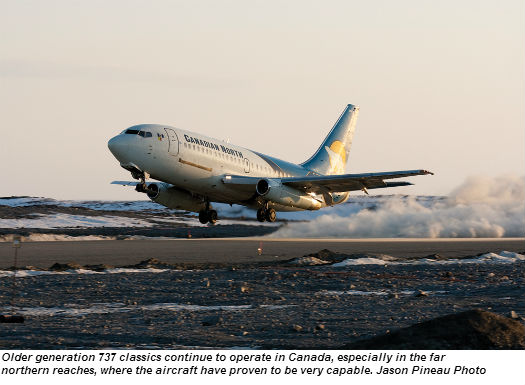The Boeing Company scored a major win last December when Air Canada announced it had selected the Boeing 737 MAX to replace its narrow-body Airbus fleet. Since November 2005, when Air Canada concluded agreements to acquire a fleet of Boeing 777 and 787 aircraft, Boeing has progressively captured the lion’s share of the passenger jet sales in Canada, as well as military sales of the CC-177 Globemaster III and CH-147F Chinook for the Royal Canadian Air Force.
Last August, WestJet announced a $6.3 billion order (at list prices) for 65 737 MAX jets; and Air Canada’s December order totalled $6.5 billion for 61 737 MAXs. Both airlines will receive their first new 737 MAX aircraft in 2017, when production is scheduled to begin.
Air Canada’s switch from Airbus to Boeing narrow-bodies is certainly the biggest news. Such supplier changes are extremely rare, because of the increased pilot training, infrastructure and maintenance engineering costs.
The MAX orders are set against a backdrop of other multi-billion dollar Boeing transactions, which include WestJet’s purchase of 105 Next-Generation Boeing 737-600/700/800s since 2001; Air Canada’s purchase of six wide-body Boeing 777-200s and 17 Boeing 777-300s since 2006; and the forthcoming deliveries of 37 new Boeing 787 Dreamliners for Air Canada, scheduled to begin arriving as early as March 2014.
Tipping Point
The commercial aircraft business is a blood sport that sees the Boeing-Airbus duopoly aggressively competing for worldwide sales.
The current round of airline fleet renewal programs was triggered when Pratt & Whitney, and later CFM, launched development of a new generation of turbofan engines. The new powerplants were advertised as incorporating a “step change” in engine technology, promising a double-digit improvement in fuel consumption, noise, emissions and operating costs.
The goal of any engine manufacturer is to place its engines on the wings of new generation aircraft, thereby stimulating a competitive threat that drives other aircraft manufacturers to re-engine their existing designs.
Current trends began when Pratt & Whitney launched development of its new PW1000 geared turbofan engine to reclaim its share of the narrow-body jetliner market–well before the price of jet fuel soared to record highs in 2008.
Then, CFM International (a Snecma-GE joint venture) launched development of the LEAP turbofan (formally called LEAP-X) in 2008.
The PW1000G gained sales momentum when it was selected in 2006-2007 to power the brand new Bombardier CSeries, as well as Mitsubishi’s MRJ jetliners.
Then, in 2009, Chinese aircraft manufacturer COMAC chose the CFM LEAP-1C (takeoff thrust up to 30,000 pounds) as the sole Western powerplant for its new C919, opting for an integrated propulsion system (IPS) that includes the engine, nacelle and thrust reverser.
At the end of 2010, Airbus selected both the CFM International LEAP-1A (takeoff thrust up to 30,900 pounds) and Pratt & Whitney PW1100G-JM as optional engines for its new A320Neo (New Engine Program).
Boeing held back as the A320neo gained sales, then jumped into the re-engine game when it selected the CFM LEAP-1B engine (takeoff thrust up to 28,000 pounds) to power the Boeing 737 MAX, which was launched by Southwest Airlines with an order for 150 aircraft in December 2011.
CFM LEAP-1B
The design of the LEAP-1B was frozen just over a year ago, with testing of the first engine expected in mid-2014, flight-testing in 2015, certification in 2017 and entry into service in 2017.
The engine has a more-conventional, two-spool, direct-drive configuration; with an 18-blade composite fan with an 11:1 bypass ratio; a 10-stage, high-pressure turbine with a 22:1 pressure ratio to reduce fuel burn; a new, lean-burn combustor that will provide low nitrogen oxide emissions; and a seven-stage, low-pressure turbine.
Cold weather and icing trials for the LEAP engines (and all new GE and CFM centre line engines) will be carried out at General Electric’s $50-million engine testing, research and development centre (TRDC) at Winnipeg’s James A. Richardson International Airport.
The test facility is a partnership between GE and StandardAero, and replaces GE’s previous facility at Montreal’s Mirabel airport.
MAX Everything
“The MAX is the next step in the Boeing 737 story,” Randy Tinseth, vice president of marketing at Boeing Commercial Airplanes, told Skies. “The aircraft features the CFM LEAP-1B engines, new advanced technology winglets, improved aerodynamics and upgraded flight displays.”
The 737 MAX is based on the 737 Next Generation (NG) family introduced in 1997, and includes three family members: the 737-700 (MAX 7), 737-800 (MAX 8) and 737-900 (MAX 9).
During the production life of the 737 NG, Boeing has introduced enhancements such as advanced technology “blended” winglets (to improve fuel economy), and replaced steel brakes with carbon models to save weight, said Tinseth.
With the new engines and other refinements, Boeing now expects the 737 MAX to have a total fuel savings of 14 per cent over the 737 NG models.
In the cockpit, the Boeing 737 MAX instrument panel will feature new large-format flight deck displays supplied by Rockwell Collins. The new displays will deliver enhanced visuals, improved reliability, lower spares and maintenance costs, lower weight and lower upgrade costs over the life of the airplane. The flight deck layout will maintain operational commonality with the Next Generation 737 for ease of pilot training, while preparing the 737 MAX for future flight deck capabilities.
“With the new 737 Boeing Sky Interior (as standard) we are also bringing the look and feel of the Boeing 787 interior to passengers of single-aisle aircraft,” explained Tinseth.
The first 737 NG with the optional Boeing Sky Interior was delivered in October 2010, and it has been selected by 60 airline customers. The 1,000th 737 with this interior was delivered in February 2014. It features modern sculptured sidewalls and window reveals, LED lighting that enhances the sense of spaciousness, and larger pivoting overhead stowage bins.
Boeing began developing the 737 MAX in August 2011, and “we’re looking at first flight in 2016 and entry into service in 2017,” said Tinseth.
He added that Boeing is strengthening the structure of the wing and fuselage of the 737 MAX, while retaining the main landing gear of the 737 NG. “But we are lengthening the nose gear by five inches and moving the engine nacelles up and outwards, to accommodate the (68-inch diameter) fan of the bigger engine.”
Tinseth credits the “lighter weight” and “better aerodynamics” of the 737 MAX for its sales success.
“We started later than the A320neo, but since then we have split the market with good demand from legacy and low-cost carriers, as well as charter airlines.”
As of mid-February 2014, Boeing had sold 1,783 737 MAX aircraft to 32 customers, not including the Air Canada sale, which had not been finalized.
Canadian Boeing 737s
The Boeing 737 has been a part of the Canadian airline scene since the first Pratt & Whitney JT8D-9A powered 737-200s entered service with CP Air, Nordair and Pacific Western in 1968.
In fact, all of Canada’s original regional airlines of the 1970s flew Boeing 737s (Eastern Provincial, Quebecair, Nordair, Transair and Pacific Western), many of which later joined the fleet of Canadian Airlines International. Nordair used 737s to introduce scheduled jet service to Frobisher Bay (now Iqaluit) in the high Arctic, establishing the gravel-runway-capable 737-200 and 737-200C “combi,” which are valued northern aerial workhorses to this day.
The Boeing 737-800 NG also forms the backbone of Canada’s highly competitive leisure airline business, in the fleets of Sunwing Airlines and CanJet Airlines, and now Air Transat, which began introducing its first 737-800 NGs in early 2014.
Canadian industry’s connection to the Boeing 737 is almost 50 years old, dating back to July 1965, when Jarry Hydraulics of Montreal received a $500,000 order to build 25 sets of main landing gear for the new twinjet.
Since then, Canadian workers employed by Jarry Hydraulics (and its successors Menasco, Goodrich and UTC Aerospace Systems, now located in Oakville, Ont.,) have delivered more than 7,900 sets of 737 landing gear to the Boeing factory in Renton, Wash., where production of the 737 is ramping up to 47 aircraft a month.
WestJet Boeing 737 MAX
There were 188 Boeing 737s registered in Canada as of mid-February 2014, with WestJet accounting for 56 per cent of the total.
WestJet was launched as a Canadian low-cost carrier in 1996, and was modelled after Texas-based Southwest Airlines, including its all Boeing 737 fleet.
In 2001, WestJet took delivery of its first Boeing Next-Generation 737 aircraft and retired its last 737-200 in 2005.
In September 2013, WestJet finalized an order for 65 Boeing 737 MAX aircraft (25 MAX 7s and 40 MAX 8s), with the deal also including the conversion of an existing order for 17 737 NG aircraft to 737 MAX aircraft.
In early February 2014, WestJet had 105 Boeing 737 NGs in service (and eight Bombardier Q400 turboprops).Over the next four years, the airline is also scheduled to receive 13 new Boeing 737-700 NGs and 12 new 737-800 NGs before the first four 737 MAX 8s arrive in 2017. WestJet will be one of the first airlines to fly the new model in North America.
WestJet says it has the ability to renew leases on its exiting aircraft, giving it the flexibility to operate as many as 162 Boeing 737 NG and MAX aircraft or as few as 120 Boeing 737 aircraft by 2023.
In July 2014, a new chapter will begin in the WestJet story, when the airline begins its first long-haul transatlantic service, flying Boeing 737 NGs between St. John’s, N.L., and Dublin, Ireland.
The 737 MAX has about a 500-mile (805-kilometre) advantage over the 737 NG, as a result of the lower fuel burn of the LEAP-1B, but this will not give the 737 MAX the long legs to match the out-of-production Boeing 757, said Boeing’s Tinseth.
WestJet has identified growth opportunities in the $2-billion international and $10-billion long haul international travel markets, which will almost certainly see Boeing and Airbus compete aggressively for any wide-body requirement.
Air Canada 737 MAX
In 1988, Air Canada announced an order for 34 Airbus A320s to replace 34 Boeing 727-200s, just prior to the federal government selling its stake in the national airline.
The introduction of the A320 was a major technological leap for Air Canada, with the fly-by-wire twinjet replacing the three-engined Boeing 727-200, which had a three-crew cockpit, including a flight engineer.
Air Canada subsequently bought two other members of the A320 family–the smaller A319 and larger A321–as well as wide-body Airbus A340 and A330 passenger jets.
The airline launched its fleet renewal plan after emerging from bankruptcy and restructuring in 2004. It ordered 45 Embraer E190 jets to fly thin intra-Canada and trans-border routes, and 15 E175s for regional services flown by mainline pilots.
Then, in 2005, Boeing 777-200s and 777-300s were selected to replace Airbus A340-200s and A340-300s, and the Boeing 787 was also selected to replace Boeing 767-300s. However, Air Canada saw its deliveries slip by four years.
Air Canada had 89 narrow-body Airbus aircraft in its fleet when the Boeing 737 MAX order was announced on Dec. 11, 2013. The commercial terms of the deal are proprietary and had not been released by mid-February, but Boeing’s Tinseth said the 737 MAX’s greater range and passenger capacity helped win the deal, as well as “the long-term benefits of the aircraft over 20 to 25 years” from a revenue and cost perspective.
Air Canada has said that, “The projected fuel burn and maintenance cost savings of a per seat basis of greater than 20 per cent will generate an estimated CASM (cost per available seat mile) reduction of approximately 10 per cent, as compared to our existing narrow-body fleet.” Fuel represents about 30 per cent of Air Canada’s annual expenditures.
The airline will begin receiving 737 MAX aircraft in the first year of production, with two aircraft in 2017, 16 in 2018, 18 in 2019, 16 in 2020 and nine in 2021.
In the meantime, it continues to reconfigure its fleet with the transfer of Embraer E175s to Sky Regional Airlines, as well as gradually moving its A319s to its low cost carrier, Air Canada rouge. Rouge is adding 18 seats to each of the A319s to achieve a 21 per cent lower CASM. Savings are also obtained through a lower labour cost structure.
The Boeing 737 MAX order announcement confirmed Air Canada’s plans to retire its 45 Embraer E190s, which are an average of just 6.8 years old.
Boeing is going to acquire 20 E190s as part of the complex deal, and will provide interim aircraft (presumably Boeing 737 NGs) to Air Canada in advance of the first 737 MAX deliveries.
Both Air Canada and Bombardier have confirmed that the new 110-to-150 seat CSeries is under consideration to replace the remaining 25 Embraer E190s in the mainline carrier’s fleet.
The trickledown effect of the high stakes Boeing-Air Canada deal means that more Canadian passengers, pilots, airports and airline employees will be flying in, servicing and maintaining Boeing aircraft than at any time in the past.

